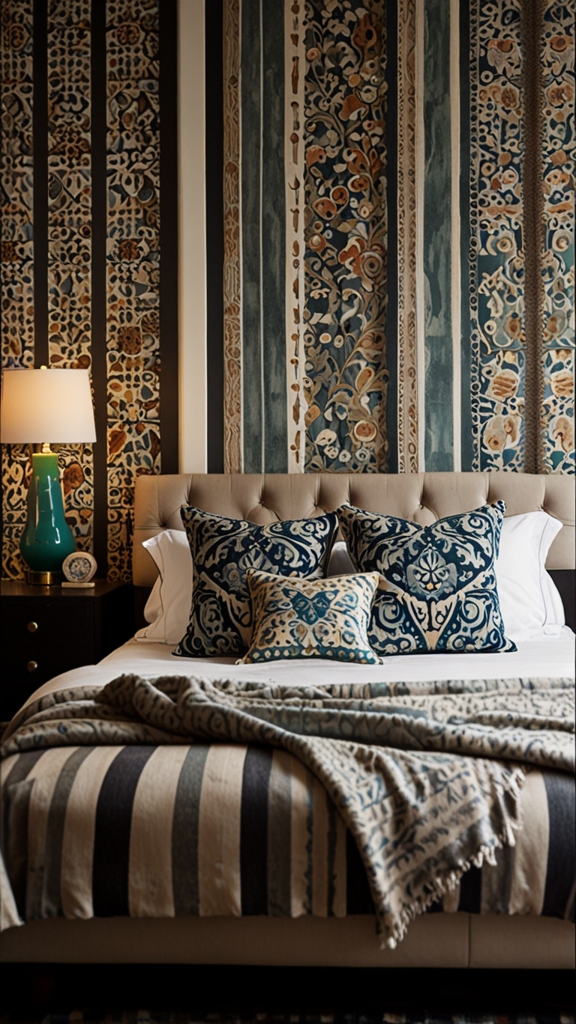Mixing and matching patterns can bring life, personality, and style to a bedroom. However, many people hesitate to try this decorating approach for fear of creating a chaotic, overwhelming space. The good news is that with a little thought and planning, you can seamlessly combine patterns to design a balanced, beautiful bedroom that feels both stylish and restful. Below is a comprehensive guide to mixing and matching patterns in your bedroom without going overboard.
1. Start with a Base Color Palette

The key to successfully mixing patterns is establishing a cohesive color palette as your foundation. Choose one or two primary colors and one or two complementary neutrals (such as whites, grays, or creams). By sticking to a defined palette, even bold patterns can coexist harmoniously.
Tips for Building Your Palette:
- Use the 60-30-10 rule: 60% dominant color, 30% secondary color, and 10% accent color.
- Opt for soft, muted tones if you prefer a calmer look. If you love vibrancy, jewel tones or brighter hues work well.
- Neutrals like beige, gray, or soft white can tie different patterns together, helping the space look balanced.
For example, a bedroom with navy blue, soft gray, and white can accommodate various patterns like stripes, florals, and geometric prints without feeling busy.
2. Mix Different Types of Patterns

Incorporating a variety of patterns creates interest and depth. Avoid using patterns that are too similar, as they can compete for attention. Instead, aim for a mix of pattern styles that complement each other.
Types of Patterns to Consider:
- Stripes: Classic and versatile, stripes can act as a neutral base to balance more intricate patterns.
- Florals: Soft and romantic, floral patterns bring a sense of charm and freshness to a room.
- Geometric Prints: These add structure and a modern feel.
- Polka Dots: Fun and whimsical, polka dots work as a smaller-scale pattern.
- Plaid or Checks: Perfect for adding warmth and a traditional vibe.
- Abstract Prints: Edgy and artistic, abstract patterns give the space a contemporary twist.
Example of Balanced Pattern Mixing: Pair a floral bedspread with striped pillowcases and a geometric rug. The differing pattern styles add dimension while ensuring the space feels visually intriguing.
3. Vary the Scale of the Patterns

Scale refers to the size of the patterns. Mixing patterns of different scales is one of the secrets to avoiding a cluttered look. A well-balanced room typically includes large, medium, and small-scale patterns.
How to Balance Scale:
- Large Patterns: Use these on larger pieces, such as bedding, curtains, or an accent wall.
- Medium Patterns: Introduce medium-scale patterns on items like throw blankets or decorative pillows.
- Small Patterns: Incorporate small prints through accessories, such as lampshades, a small ottoman, or a bed runner.
For example, a large floral print duvet paired with smaller geometric-print cushions and a striped throw creates a visually pleasing mix without overwhelming the room.
4. Limit the Number of Patterns

While mixing patterns adds personality, too many patterns can quickly overwhelm the space. Stick to a maximum of three to four patterns in a single bedroom to keep the design cohesive.
Pattern Pairing Ideas:
- Stripes + Florals + Solids
- Plaid + Polka Dots + Neutral Textures
- Geometric Print + Small-Scale Abstract + Large-Scale Floral
Always ensure that the colors within the patterns tie back to your original color palette to maintain harmony.
5. Balance Busy Patterns with Solids

Solid colors are your best friend when it comes to balancing bold patterns. They act as visual breathing space, preventing the room from feeling overstimulating.
Ways to Use Solids:
- Use a solid-color bedspread or duvet as a foundation if the pillows, rugs, and curtains feature busy patterns.
- Layer patterned pillows on a solid sofa or armchair.
- Incorporate solid furniture pieces, like a neutral headboard or side tables, to ground the design.
For example, if your curtains and bedding feature patterns, opt for a solid-color rug to balance out the visuals.
6. Layer Textures for Depth

Mixing patterns doesn’t just mean prints; textures can also play a significant role in enhancing the design. Layering textures adds dimension and helps patterns stand out without competing with each other.
Textural Elements to Add:
- Velvet cushions
- Linen or cotton bedspreads
- Faux fur throws
- Woven rugs
- Knit blankets
Combining different materials ensures the room feels cozy and well-rounded. For instance, layer a chunky knit throw over a floral bedspread for an inviting, textured look.
7. Use Patterns Strategically

When mixing patterns, consider where each pattern will make the biggest impact without overpowering the space.
Placement Tips:
- Use bold patterns as focal points, such as on bedding, an accent chair, or a statement rug.
- Keep smaller patterns for secondary elements, like throw pillows, lampshades, or small pieces of decor.
- If you want to experiment with an eye-catching wall, try patterned wallpaper on a single accent wall rather than the entire room.
For example, a bold striped rug can anchor the room, while softer floral or abstract prints complement it through bedding and pillows.
8. Incorporate Neutral Patterns

Neutral patterns (like white-and-gray stripes or beige plaid) add subtle interest to a space while preventing it from feeling overwhelming. These work well alongside more colorful or bold patterns.
Neutral Patterns to Try:
- Houndstooth
- Ticking stripes
- Chevron in muted tones
- Monochromatic plaids
For instance, a neutral striped rug can beautifully balance a brightly patterned quilt or floral curtains without stealing the spotlight.
9. Repeat Patterns for Cohesion

Repeating a pattern or design element throughout the bedroom helps tie everything together. For example:
- Use striped curtains and add smaller striped pillows to the bed.
- Repeat a floral print from the bedding onto artwork or lampshades.
- Carry a geometric motif across the rug and decorative accessories.
This repetition creates a sense of unity, making the overall design look intentional and well-curated.
10. Test the Patterns Before Finalizing

Before committing to a mix of patterns, test how they look together. Use swatches or samples to visualize the combination.
Tips for Testing:
- Lay fabric samples on the bed or floor to see how they interact.
- Compare patterns under both natural and artificial light.
- Create a mood board to arrange patterns, colors, and textures.
Testing your choices beforehand ensures you feel confident in the final design.
Conclusion
Mixing and matching patterns in your bedroom doesn’t have to be intimidating. By starting with a cohesive color palette, balancing scale, incorporating solids, and strategically layering textures, you can create a space that feels visually interesting yet serene. Remember to limit the number of patterns, repeat elements for cohesion, and always test your ideas before finalizing the look.
With these tips, you’ll achieve a beautifully patterned bedroom that feels stylish, balanced, and uniquely yours.







